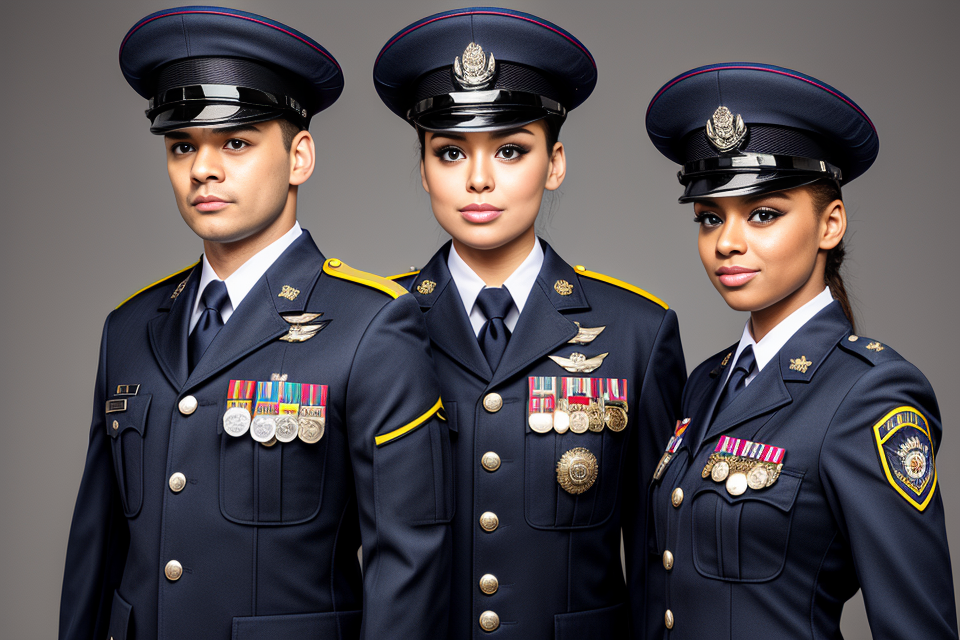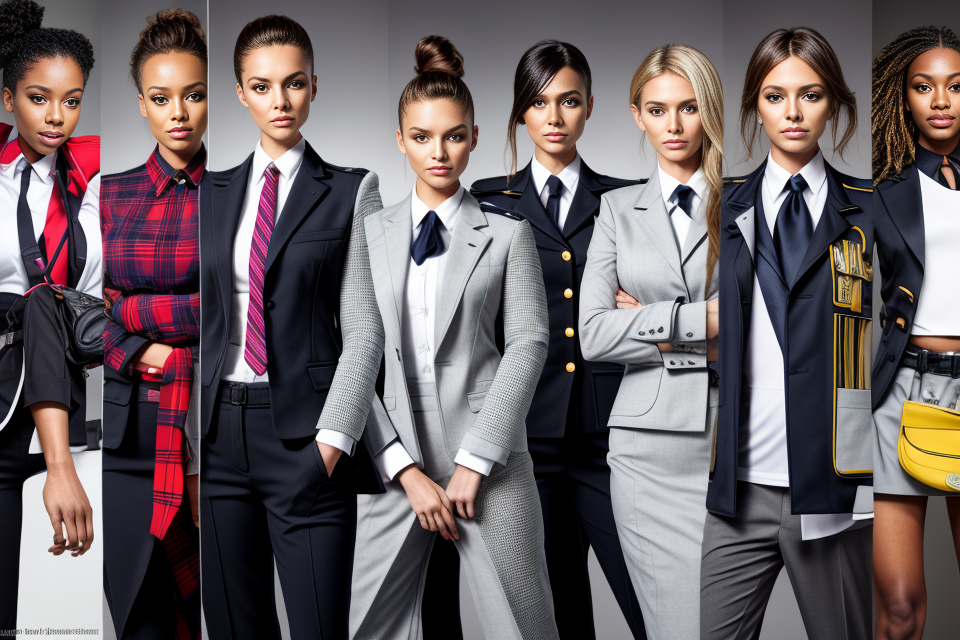
A uniform is a set of standardized clothing worn by individuals in a particular organization or profession. It serves as a symbol of identity, unity, and pride. But what does a uniform really indicate? Is it just a way to differentiate between different groups or does it hold deeper meaning? In this article, we will explore the various aspects of a uniform and what it represents. From the history of uniforms to their psychological impact, we will delve into the symbolism behind the clothes we wear. So, join us as we unravel the hidden meanings behind the uniforms that we see every day.
A uniform is a set of standardized clothing worn by members of a particular group or organization to identify themselves as part of that group or organization. Uniforms are often used in the military, law enforcement, and other public service professions, but they can also be worn by school students, sports teams, and other groups. The specific design and colors of a uniform can vary depending on the group or organization, but the main purpose of a uniform is to create a sense of unity and identity among its wearers. In many cases, the uniform is also intended to convey a certain level of professionalism or authority.
The history of uniforms
Ancient origins
Uniforms in ancient Rome
The use of uniforms can be traced back to ancient Rome, where they were primarily used for military purposes. Roman soldiers were required to wear uniforms that identified them as members of a specific legion. These uniforms consisted of a tunic with a distinctive design that indicated the soldier’s rank and unit.
Military uniforms
Military uniforms in ancient Rome served several purposes. They helped to identify friend from foe on the battlefield, allowing soldiers to distinguish between their own comrades and the enemy. Additionally, uniforms helped to create a sense of unity and discipline among the troops. By wearing a uniform, soldiers were reminded that they were part of a larger whole and were expected to adhere to a certain set of rules and standards.
Religious uniforms
In addition to military uniforms, ancient Rome also had a tradition of wearing religious uniforms. These uniforms were worn by priests and other religious officials and often consisted of a distinctive robe or tunic. The use of religious uniforms was intended to signify the wearer’s religious status and to demonstrate their devotion to a particular deity or religious tradition.
Uniforms in medieval Europe
Knights and nobility
During the medieval period in Europe, uniforms were often worn by knights and other members of the nobility. These uniforms typically consisted of a distinctive coat of arms or other heraldic device that identified the wearer’s family or social status. The use of these uniforms was intended to demonstrate the wearer’s prestige and to show their allegiance to a particular lord or kingdom.
Peasants and commoners
While the nobility and knights wore distinctive uniforms, peasants and commoners did not have the same privilege. In fact, during the medieval period, it was often forbidden for commoners to wear certain types of clothing or styles of dress. This was intended to reinforce social hierarchies and to prevent commoners from appearing too much like members of the nobility. However, some peasants and commoners did manage to wear uniforms or distinctive clothing as part of their professions, such as monks, nuns, and members of certain guilds.
Uniforms in modern times
Industrial revolution and uniforms
During the industrial revolution, uniforms became increasingly popular as a way to identify and differentiate between different professions. The use of uniforms was also seen as a way to maintain a sense of order and discipline in the workplace.
Factory workers
In factories, uniforms were often used to identify different departments or job functions. For example, workers in the assembly line might wear one color, while workers in the shipping department might wear another. This helped to improve efficiency and communication within the factory.
Police and firefighters
The use of uniforms for police and firefighters dates back to the late 19th century. The idea was to create a sense of unity and identity among law enforcement and emergency responders. The uniforms also served as a way to quickly identify officers or firefighters in case of an emergency.
In modern times, the use of uniforms has continued to evolve and expand to include a wide range of professions and industries. From healthcare workers to airline pilots, uniforms are an important part of many people’s jobs. They serve as a way to identify and distinguish between different roles, and also help to establish a sense of professionalism and authority.
Uniforms in society
Symbol of authority
Police and military
In modern society, a uniform is often seen as a symbol of authority, particularly in the context of law enforcement and the military. Police officers and military personnel wear uniforms that identify them as representatives of the state, with the power to enforce laws and maintain order.
Enforcing laws and order
Police uniforms are designed to convey a sense of authority and instill trust in the public. When an officer is in uniform, they are seen as an official representative of the law, and their presence alone can deter criminal activity. The uniform is a visual reminder of the officer’s role in maintaining public safety and upholding the law.
Maintaining peace and security
The military is another institution where uniforms serve as a symbol of authority. Soldiers wear uniforms that identify them as members of a particular branch of the military, and their presence on the battlefield or in a conflict zone is a reminder of the state’s ability to protect its citizens. The uniform is a symbol of the military’s strength and readiness to defend the nation from external threats.
Teachers and school staff
Uniforms are also worn by teachers and other school staff, who are seen as authority figures in the educational system. The uniform is a visual reminder of the teacher’s role as an educator and guide, and it helps to establish a sense of order and discipline in the classroom.
Authority figures
Teachers who wear uniforms are often seen as more authoritative figures in the eyes of their students. The uniform serves as a visual cue that the teacher is in charge and is expected to be respected. This can help to establish a more orderly classroom environment, where students are more likely to pay attention and follow instructions.
Maintaining discipline
Uniforms can also help to maintain discipline in the classroom. When students see their teachers wearing uniforms, they are more likely to understand that there are rules and expectations that must be followed. The uniform serves as a visual reminder of the need for discipline and order, and it can help to prevent disruptive behavior.
Overall, uniforms serve as a powerful symbol of authority in society, conveying a sense of order and discipline that is necessary for the functioning of institutions like law enforcement, the military, and education.
Identification and belonging
Sports teams
Uniforms play a crucial role in identifying members of a sports team. They help to differentiate players from opposing teams and allow spectators to easily recognize and support their favorite players. Wearing a team uniform also fosters a sense of belonging and unity among team members, as they all wear the same uniform and share a common goal.
Members of a team
A uniform serves as a visual cue to identify members of a sports team. It allows players to easily recognize one another on the field and helps to create a sense of identity and belonging within the team. Wearing a team uniform also promotes a sense of pride and loyalty among players, as they represent their team and its values.
Team spirit and camaraderie
Wearing a team uniform can also foster a sense of team spirit and camaraderie among players. When everyone is wearing the same uniform, it creates a sense of unity and shared experience. Players are able to bond over their shared commitment to the team and their common goal of winning. This sense of belonging and shared identity can help to motivate players and create a positive team dynamic.
The importance of uniforms
Functionality
Comfort and practicality
One of the primary functions of a uniform is to provide comfort and practicality to the wearer. Uniforms are designed to be durable, comfortable, and easy to maintain, which means that they can be worn for long periods without causing discomfort or distraction. This is particularly important for professions that require physical activity, such as healthcare, construction, and law enforcement, where workers need to be able to move freely and perform their duties without being hindered by their clothing.
Safety and protection
Another key function of a uniform is to provide safety and protection to the wearer. Uniforms are often designed with specific materials and features that protect the wearer from potential hazards on the job. For example, firefighters wear uniforms made of fire-resistant materials to protect them from the heat and flames of a fire, while construction workers wear hard hats and reflective vests to protect them from falling debris and passing vehicles.
Standardization and efficiency
Uniforms also serve the function of standardizing and promoting efficiency in the workplace. By providing a consistent visual representation of the company or organization, uniforms help to create a sense of unity and professionalism among employees. This can lead to increased morale and a sense of pride in the company, as well as improved communication and collaboration among team members. Additionally, uniforms can help to streamline operations by eliminating the need for employees to decide what to wear each day, which can save time and reduce confusion.
Psychological impact
Social influence and conformity
Uniforms have a significant impact on social influence and conformity. People tend to follow the crowd and conform to societal norms, and this is evident in the way they dress. When individuals wear a uniform, they are more likely to conform to the expectations of their peers and follow the established norms of their social group. This can be seen in the way that school uniforms, for example, can influence the behavior of students, making them more likely to conform to the norms of their school and peer group.
Identity and self-expression
Uniforms also play a role in identity and self-expression. When individuals wear a uniform, they are often limited in their ability to express their individuality and personal style. This can have an impact on their sense of identity and self-expression, as they may feel constrained by the limitations of the uniform. For example, a school uniform may not allow for much personal expression, which can make students feel like they are losing a part of themselves.
Perceptions of power and authority
Uniforms can also influence perceptions of power and authority. When individuals wear a uniform, they are often seen as having less power and authority than those who do not. This is because uniforms are often associated with subservience and obedience, and individuals in uniforms are often seen as being under the authority of someone else. This can have an impact on how individuals are perceived by others, and can limit their ability to assert their own power and authority.
Uniform etiquette and rules
Dress code and appearance guidelines
A uniform is a set of standardized clothing worn by individuals in a particular organization or profession. The dress code and appearance guidelines for a uniform are designed to maintain a consistent image and convey a sense of professionalism.
Proper wear and care of uniforms
Proper wear and care of uniforms is essential to maintain a professional image. Uniforms should be clean, pressed, and in good repair. Uniforms should be worn as per the instructions given by the organization. Any damage or stains should be reported and addressed immediately.
Hygiene and grooming standards
Hygiene and grooming standards are essential for maintaining a professional image. Uniforms should be clean and well-maintained. Employees should maintain a clean and neat appearance at all times. This includes maintaining a well-groomed hairstyle, clean and trimmed nails, and proper use of makeup (if applicable).
Requirements for off-duty wear
Some organizations may have specific requirements for off-duty wear. This includes wearing the uniform outside of work hours or during off-duty activities. Employees should adhere to these requirements to maintain a consistent image and professionalism. Off-duty wear should be in line with the organization’s dress code and should not detract from the professional image.
Disciplinary actions and consequences
When it comes to violations of the dress code or failure to follow uniform guidelines, disciplinary actions and consequences may vary depending on the organization or institution. However, it is important to note that uniforms are a symbol of professionalism and represent the organization or institution in a certain way. As such, it is essential to maintain the integrity of the uniform and adhere to the rules and regulations set forth by the organization.
Some possible disciplinary actions and consequences for violations of the dress code or failure to follow uniform guidelines may include:
- Verbal warning: A verbal warning may be given to an individual who has violated the dress code or failed to follow the uniform guidelines. This may be done in private or in front of other staff members, depending on the severity of the violation.
- Written warning: If the violation is more serious, a written warning may be issued. This serves as a formal record of the violation and may be kept on file in the employee’s personnel file.
- Suspension: In some cases, an individual may be suspended from work for a period of time if they have violated the dress code or failed to follow the uniform guidelines. This may be done with or without pay, depending on the organization’s policies.
- Termination: In the most severe cases, an individual may be terminated from their position if they have repeatedly violated the dress code or failed to follow the uniform guidelines. This may be done if the violations are considered to be a significant breach of the organization’s policies or if the individual has ignored previous warnings or disciplinary actions.
It is important for individuals to understand the consequences of violating the dress code or failing to follow the uniform guidelines, as this can impact their job performance, professional reputation, and future career prospects. It is also important for organizations to enforce these rules consistently and fairly, in order to maintain the integrity of the uniform and ensure that all staff members are held to the same standards.
Uniforms in popular culture
Movies and television
In movies and television, uniforms often serve as a visual shorthand to convey information about a character’s profession, social status, or even personality. However, they can also be used to reinforce stereotypes and cliches, perpetuating harmful societal attitudes.
Stereotypes and cliches
One common use of uniforms in movies and television is to reinforce stereotypes and cliches. For example, a police officer’s uniform may be used to depict them as strict, authoritative figures who always follow the rules. Similarly, a doctor’s white coat may be used to depict them as smart, competent, and always in control. While these stereotypes may be harmless in some cases, they can also perpetuate harmful attitudes and contribute to negative stereotypes.
Realistic portrayals
However, movies and television can also use uniforms to create more realistic portrayals of professions and characters. For example, a police officer’s uniform may be depicted as worn and unkempt, reflecting the realities of a demanding and often dangerous job. Similarly, a doctor’s white coat may be shown to be stained and wrinkled, reflecting the realities of a high-pressure and emotionally taxing job. By using uniforms in this way, movies and television can create a more nuanced and realistic portrayal of professions and characters.
Uniforms as fashion statement
In some cases, uniforms are used in movies and television as a fashion statement, highlighting their design and style. For example, the iconic red uniforms of the guards in The Matrix are both functional and stylish, adding to the film’s visual appeal. Similarly, the futuristic uniforms in Blade Runner are both a reflection of the film’s dystopian world and a fashion statement in their own right. While this use of uniforms may be more stylistic than functional, it can still be effective in creating a distinct visual identity for a movie or television show.
Literature and comics
In literature and comics, uniforms are often used to identify and distinguish characters, create iconic images, and convey themes and symbolism. Uniforms can also be used to convey power dynamics and social hierarchies.
Iconic characters and costumes
Many iconic characters in literature and comics are instantly recognizable due to their distinctive uniforms or costumes. For example, Superman’s suit with the “S” symbol, Batman’s Batsuit, or Wonder Woman’s armor and lasso. These uniforms not only identify the characters but also convey their powers and abilities.
Symbolism and themes
Uniforms in literature and comics can also carry symbolic meaning and convey themes related to the story. For instance, in George Orwell’s “1984,” the uniform of the ruling party’s Inner Party members represents their power and control over the society. The simple, black uniforms contrast with the shabby, dilapidated clothing of the Outer Party members, emphasizing the class divide and the oppressive nature of the regime.
In J.K. Rowling’s “Harry Potter” series, the robes worn by students at Hogwarts School of Witchcraft and Wizardry represent the magical nature of the school and its students. The color of the robes indicates the student’s house affiliation, adding to the sense of community and belonging within the school.
Uniforms as symbol of power
Uniforms can also be used to symbolize power dynamics and social hierarchies. In “The Handmaid’s Tale” by Margaret Atwood, the uniforms worn by the handmaids represent their subjugation and objectification by the ruling class. The white, winged cape and red dress symbolize the handmaids’ role as fertile vessels for the ruling class, reinforcing their powerlessness and oppression.
In contrast, in “The Hunger Games” by Suzanne Collins, the elaborate and ornate costumes worn by the wealthy Capitol citizens represent their excessive wealth and power. The gaudy and extravagant costumes contrast with the simple, utilitarian clothing of the poorer districts, highlighting the vast social divide between the ruling class and the oppressed population.
Overall, uniforms in literature and comics serve to create distinctive and memorable characters, convey themes and symbolism, and reinforce power dynamics and social hierarchies.
Art and fashion
Uniforms as inspiration for design
In the world of art and fashion, uniforms have been a constant source of inspiration for designers. From military and police uniforms to school and work uniforms, designers have taken the basic structure and aesthetic of these uniforms and incorporated them into their designs. This has led to the creation of many iconic fashion pieces, such as the iconic Chanel suit and the classic Levi’s denim jacket.
Fashion statements and political statements
Uniforms have also been used as a means of making a fashion or political statement. For example, in the 1960s and 1970s, the hippie movement adopted a uniform of sorts, with bell-bottom jeans, tie-dye t-shirts, and fringed vests becoming the de facto dress code for the counterculture. Similarly, in the 1980s, the punk movement adopted a uniform of black leather jackets, ripped jeans, and spiky hair, as a means of rejecting mainstream fashion and society.
Experimentation with uniform styles
In recent years, there has been a trend of experimentation with uniform styles in the fashion industry. Designers have been playing with the traditional uniform silhouette, incorporating it into more avant-garde designs. This has led to the creation of unique and interesting fashion pieces, such as oversized blazers, asymmetrical hemlines, and deconstructed collars. The trend has also seen the incorporation of more unconventional materials, such as plastic and neoprene, into traditional uniform fabrics like wool and cotton.
FAQs
1. What is a uniform?
A uniform is a set of standardized clothing or attire worn by individuals as part of their job, profession, or membership in a particular group or organization.
2. What does a uniform indicate?
A uniform indicates that the person wearing it belongs to a particular group, organization, or profession, and that they adhere to certain standards, rules, and regulations. It also signifies a level of authority, responsibility, and accountability.
3. Are uniforms only worn by professionals or employees?
No, uniforms are not only worn by professionals or employees. They can also be worn by members of clubs, teams, organizations, or even schools. In some cases, uniforms are used to identify individuals who are part of a particular group or community.
4. Can people wear whatever they want while in uniform?
No, people who are wearing a uniform are expected to follow certain guidelines and rules regarding the type of clothing they wear, the condition of the uniform, and how they present themselves while in uniform. Failure to adhere to these guidelines can result in disciplinary action.
5. Are there any benefits to wearing a uniform?
Yes, there are several benefits to wearing a uniform. It promotes a sense of unity and belonging among members of a group or organization. It also helps to establish a professional image and enhances the credibility of the individual or organization. Additionally, wearing a uniform can simplify the process of choosing what to wear each day, as the uniform is already specified.


